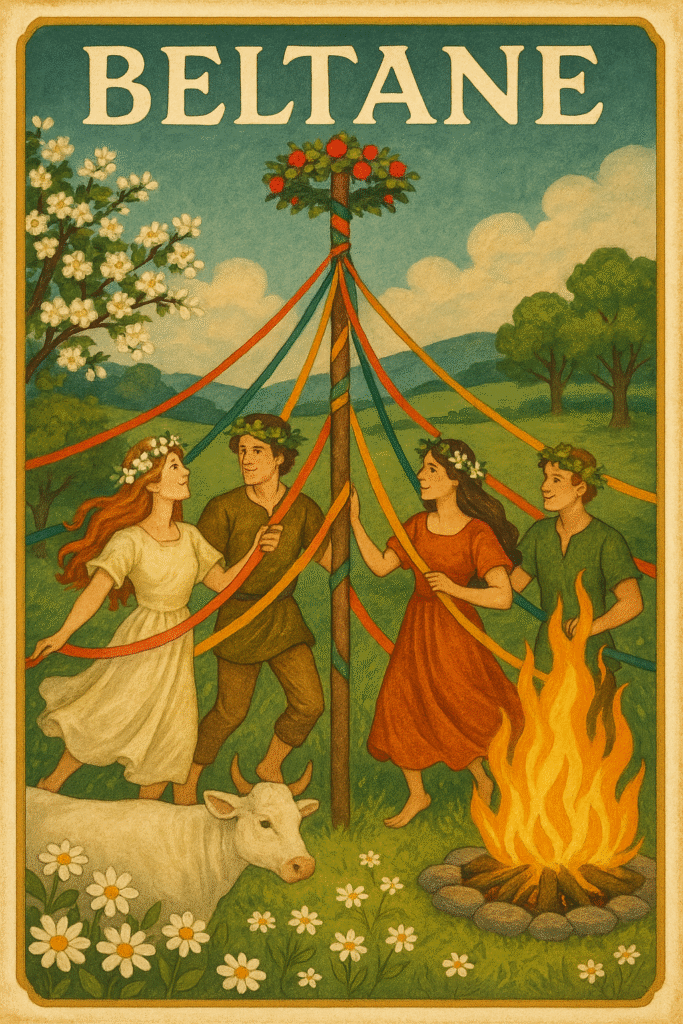
Beltane, traditionally celebrated on 1 May, is one of the four major seasonal festivals, alongside Samhain, Imbolc, and Lammas. Marking the midpoint between the spring equinox and summer solstice, Beltane heralds the height of spring and the approach of summer. It is a fire festival rooted in ancient Celtic tradition, honouring fertility, vitality, and the sacred union of masculine and feminine energies. In contemporary Pagan and Wiccan practice, Beltane remains a vibrant celebration of life, sensuality, and the blossoming of nature.
Historical Origins
The name “Beltane” derives from the Old Irish Beltene, meaning “bright fire” or “Bel’s fire,” referencing the Celtic god Belenus, associated with healing and the sun. Identical to the Welsh celebration of Calan Mai describe it as a time when cattle were driven between two bonfires to ensure protection and fertility for the coming season.
In pre-Christian Gaelic societies, Beltane marked the beginning of the pastoral summer. Communities lit sacred fires on hilltops, such as Uisneach in Ireland, and engaged in rituals to bless livestock, crops, and relationships. Though suppressed during Christianisation, Beltane customs persisted in folk traditions across Ireland, Scotland, and the Isle of Man.
Folklore and Symbolism
Beltane is rich in folkloric motifs that celebrate the union of opposites and the potency of nature:
- The Maypole: A central symbol of Beltane, the maypole represents the phallic force of nature. Ribbons spiralling around the pole symbolise the weaving together of masculine and feminine energies. Dancers encircle the pole in ritualised movement, invoking fertility and harmony.
- The Green Man and the May Queen: Folklore often personifies Beltane’s energies through the Green Man—an embodiment of wild nature and virility—and the May Queen, representing beauty, growth, and the earth’s fecundity. Their symbolic union reflects the sacred marriage of earth and sky.
- Bonfires: Fire is central to Beltane, representing purification, transformation, and the sun’s growing power. Leaping over flames or walking between fires was believed to confer blessings and protection.
- Hawthorn and Rowan: These trees are sacred to Beltane. Hawthorn blossoms, known as “May,” were used to decorate homes and altars, while rowan was employed for protective charms.
Rituals and Traditions
Modern Pagan and Wiccan communities celebrate Beltane with rituals that honour passion, creativity, and the life force:
- Fire Ceremonies: Bonfires are lit at dusk, often accompanied by drumming, dancing, and offerings. Participants may leap over flames to symbolise release and renewal.
- Handfasting: Temporary or permanent unions are consecrated through handfasting ceremonies, where couples’ hands are bound with ribbons to signify commitment and love.
- Maypole Dancing: Communities gather to dance around the maypole, weaving ribbons in intricate patterns. This communal act invokes fertility and joy.
- Floral Offerings: Altars are adorned with spring flowers—bluebells, primroses, hawthorn—and symbols of sensuality such as honey, wine, and fruit.
- Nature Immersion: Celebrants often spend time in woodlands or meadows, engaging in meditative walks, foraging, or spontaneous rituals to honour the land.
Gift-Giving and Seasonal Offerings
While Beltane is not traditionally centred on gift exchange, modern practices often include symbolic offerings and tokens of seasonal energy:
- Floral Crowns: Handmade garlands of wildflowers are gifted to friends or worn during rituals to embody spring’s vitality.
- Herbal Bundles: Dried herbs such as hawthorn, rose, and mugwort are tied in bundles for protection, love, and dreamwork.
- Crystals: Stones aligned with Beltane’s themes—such as garnet (passion), carnelian (creativity), and emerald (growth)—are exchanged to support personal transformation.
- Beeswax Candles: Representing fire and fertility, natural candles are gifted to encourage warmth and illumination.
- Seasonal Crafts: Handmade items such as woven charms, painted eggs, or Beltane-themed art are shared to honour creativity and connection.
Conclusion
Beltane is a celebration of life’s exuberance, a time to honour the sacred union of energies and the fertility of the earth. Rooted in ancient Celtic tradition and enriched by centuries of folklore, Beltane invites practitioners to embrace passion, creativity, and the wild beauty of nature. Whether through ritual, art, or quiet communion with the land, Beltane remains a potent reminder of the cyclical dance of light, growth, and renewal.
